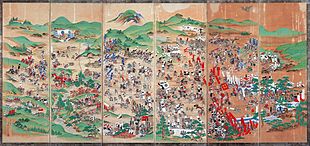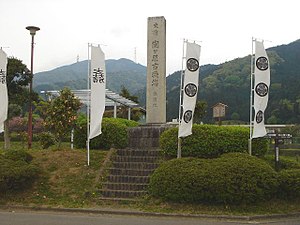Battle of Sekigahara
This article needs additional citations for verification. (October 2007) |
| Battle of Sekigahara | |||||||||
|---|---|---|---|---|---|---|---|---|---|
| Part of the Sengoku period | |||||||||
 Edo period screen depicting the battle. | |||||||||
| |||||||||
| Belligerents | |||||||||
| Forces loyal to Toyotomi Hideyori, many clans from Western Japan | Forces of Tokugawa Ieyasu, Clans of Eastern Japan | ||||||||
| Commanders and leaders | |||||||||
| Ishida Mitsunari, Mōri Terumoto, others | Tokugawa Ieyasu, others | ||||||||
| Strength | |||||||||
| 81,890[1] | 88,888[1] | ||||||||
| Casualties and losses | |||||||||
|
5,000–32,000 dead Otani Yoshitsugu Shimazu Toyohisa Toda Shigemasa Shima Sakon (wounds) |
Unknown; but not excessive Ii Naomasa (wounds) | ||||||||
The Battle of Sekigahara (Shinjitai: 関ヶ原の戦い; Kyūjitai: 關ヶ原の戰ひ, Sekigahara no Tatakai), popularly known as the Battle for the Sundered Realm (天下分け目の戦い, Tenka Wakeme no Tatakai), was a decisive battle on October 21, 1600 (Keichō 5, 15th day of the 9th month) which cleared the path to the Shogunate for Tokugawa Ieyasu. Though it would take three more years for Ieyasu to consolidate his position of power over the Toyotomi clan and the daimyo, Sekigahara is widely considered to be the unofficial beginning of the Tokugawa bakufu, the last shogunate to control Japan. Japan then had a long period of peace after that battle.
Background and pretext
Even though Toyotomi Hideyoshi unified Japan and consolidated his power following the Siege of Odawara in 1590, his failures in his invasions of Korea significantly weakened the Toyotomi clan's power as well as the loyalists and bureaucrats that continued to serve and support the Toyotomi clan after Hideyoshi's death. Hideyoshi's and his brother Hidenaga's presence kept the two sides from anything more than quarreling, but when both of them died, the conflicts were exacerbated and developed into open hostilities. Since the Toyotomi clan was known to be descended from peasant stock, neither Hideyoshi nor his heir Hideyori would be recognized or accepted as Shogun.
Most notably, Katō Kiyomasa and Fukushima Masanori were publicly critical of the bureaucrats, especially Ishida Mitsunari and Konishi Yukinaga. Tokugawa Ieyasu took advantage of this situation, and recruited them, redirecting the animosity to weaken the Toyotomi clan.
Beginning
Tokugawa Ieyasu was no longer rivaled in terms of seniority, rank, reputation and overall influence within the Toyotomi clan after the death of Regent Maeda Toshiie. Rumors started to spread stating that Ieyasu, at that point the only surviving ally of Oda Nobunaga, would take over Hideyoshi's legacy just as Nobunaga's was taken. This was especially evidebuyssnt amongst the loyalist bureaucrats, who suspected Ieyasu of agitating unrest amongst Toyotomi's former vassals.
Later, a supposed conspiracy to assassinate Ieyasu surfaced, and many Toyotomi loyalists, including Toshiie's son, Toshinaga, were accused of taking part and forced to submit to Ieyasu's authority. However, Uesugi Kagekatsu, one of Hideyoshi's appointed regents, defied Ieyasu by building up his military. When Ieyasu officially condemned him and demanded that he come to Kyoto to explain himself before the Emperor. Kagekatsu's chief advisor, Naoe Kanetsugu responded with a counter-condemnation that mocked Ieyasu's abuses and violations of Hideyoshi's rules, in such a way that Ieyasu was infuriated.
Afterwards, Ieyasu summoned the help of various supporters and led them northward to attack the Uesugi clan, which at that moment were besieging Hasedō, but Ishida Mitsunari, grasping the opportunity, rose up in response and created an alliance to challenge Ieyasu's supporters, also seizing various daimyo as hostages in Osaka Castle.
Ieyasu then left some forces led by Date Masamune to keep the Uesugi in check and marched west to confront the western forces. A few daimyo, most notably Sanada Masayuki, left Ieyasu's alliance, although most, either bearing grudges against Mitsunari or being loyal to Ieyasu, stayed with him.
The battle
Mitsunari, in his home Sawayama Castle, met with Ōtani Yoshitsugu, Mashita Nagamori, and Ankokuji Ekei. Here, they forged the alliance, and invited Mōri Terumoto, who actually did not take part in the battle, to be its head.
Mitsunari then officially declared war on Ieyasu and lay siege to the Fushimi Castle, garrisoned by Tokugawa retainer Torii Mototada on July 19. Afterwards, the western forces captured various Tokugawa outposts in the Kansai region and within a month, the western forces had moved into the Mino Province, where Sekigahara was located.
Back in Edo, Ieyasu received news of the situation in Kansai and decided to deploy his forces. He had some former Toyotomi daimyo engage with the western forces while he split his troops and marched west on the Tōkaidō towards Osaka Castle.
Ieyasu's son Hidetada led another group through Nakasendō. However, Hidetada's forces were bogged down as he attempted to besiege Sanada Masayuki's Ueda Castle. Even though the Tokugawa forces numbered some 38,000, an overwhelming advantage over the Sanada's mere 2,000, they were still unable to capture the strategist's well-defended position. At the same time, 15,000 Toyotomi troops were being held up by 500 troops under Hosokawa Fujitaka at Tanabe Castle in Wakayama Prefecture. Some among the 15,000 troops respected Hosokawa so much they intentionally slowed their pace down. Both these incidents resulted in a large number of Tokugawa and Toyotomi troops not to show up in time at the battlefield of Sekigahara.
Knowing that Ieyasu was heading toward Osaka, Mitsunari decided to abandon his positions and marched to Sekigahara. On September 15, 1600 (Keichō 5, 8th day of the 8th month), the two sides started to deploy their forces. Ieyasu's eastern army had 88,888 men, whilst Mitsunari's western army numbered 81,890. There were about 20,000 arquebusers and other forms of hand-held gunners deployed in the battlefield, corresponding to over 10% of all troops present.
Fall of the western army

Even though the western forces had tremendous tactical advantages, Ieyasu had already contacted many daimyo on the western side, promising them land and leniency after the battle should they switch sides. Notably several western commanders holding key positions were lured over to the Tokugawa cause.
Kikkawa Hiroie and Kobayakawa Hideaki were two such commanders. They were in such positions that if they decided to close in on the eastern forces, they would in fact have Ieyasu surrounded on three sides. However, Kikkawa Hiroie, who was a retainer of the Mori clan, believed that Ieyasu would ultimately be victorious, and made a secret pact to keep his clan out of the combat. Hiroie's troops formed the front lines of the Mori army, which was commanded by his cousin Mori Hidemoto. When Hidemoto decided to attack the Tokugawa forces, Hiroie refused to comply, claiming fogs prevented movement. This in turn prevented the Chosokabe army, which deployed behind the Mori clan, from attacking.
Even though Kobayakawa had responded to Ieyasu's call, in the actual battle he was hesitant and remained neutral. As the battle grew more intense, Ieyasu finally ordered arquebusiers to fire at Kobayakawa's position on Mount Matsuo in order to force Kobayakawa to make his choice. At that point Kobayakawa joined the battle on the eastern side. His forces assaulted Yoshitsugu's position, which quickly fell apart as he was already engaging Tōdō Takatora's forces. Seeing this as an act of treachery, western generals such as Wakisaka Yasuharu, Ogawa Suketada, Akaza Naoyasu, and Kutsuki Mototsuna immediately switched sides, turning the tide of battle.
The western forces disintegrated afterwards, and the commanders scattered and fled. Some, like Ukita Hideie managed to escape. Many others did not. Shima Sakon was shot and wounded by a round from an arquebus and Ōtani Yoshitsugu committed suicide. Mitsunari, Yukinaga and Ekei were some of those who were captured and a few, like Mōri Terumoto and Shimazu Yoshihiro were able to return to their home provinces. Mitsunari himself would be executed.
Rise of the Tokugawa Shogunate

Tokugawa Ieyasu redistributed the lands and fiefs of the participants, generally rewarding those who assisted him and displacing, punishing, or exiling those who fought against him. In doing so, he gained control of many former Toyotomi territories. Following the public execution of Ishida Mitsunari, Konishi Yukinaga and Ankokuji Ekei, the influence and reputation of the Toyotomi clan and its remaining loyalists drastically decreased.
At the time, the battle was considered only an internal conflict between Toyotomi vassals. However, after Ieyasu became Shogun, a position that had been left vacant since the fall of the Ashikaga shogunate 27 years earlier, the battle was perceived as a more important event. In 1664, Hayashi Gahō, Tokugawa historian and rector of Yushima Seido, summarized the consequences of the battle: "Evil-doers and bandits were vanquished and the entire realm submitted to Lord Ieyasu, praising the establishment of peace and extolling his martial virtue. That this glorious era that he founded may continue for ten thousands upon ten thousands of generations, coeval with heaven and earth."[2]
This change in official rankings also reversed the subordinate position of the Tokugawa clan, thus making the Toyotomi clan subordinates of the Tokugawa instead.
Seeds of dissent
While most clans were content with their new status, there were many clans, especially those on the western side, who became bitter about their displacement or what they saw as a dishonorable defeat or punishment. Three clans in particular did not take the aftermath of Sekigahara lightly:
- The Mōri clan, headed by Mōri Terumoto, remained angry toward the Tokugawa shogunate for being displaced from their fief, Aki, and being relocated to the Chōshū Domain, even though the clan did not take part in the battle at all.
- The Shimazu clan, headed by Shimazu Yoshihiro, blamed the defeat on its poor intelligence-gathering, and while they were not displaced from their home province of Satsuma, they did not become completely loyal to the Tokugawa shogunate either. Taking advantage of its large distance between Edo and the island of Kyūshū as well as its improved espionage, the Shimazu clan demonstrated that it was virtually an autonomous kingdom independent from the Tokugawa shogunate during its last days.
- The Chōsokabe clan, headed by Chōsokabe Morichika, was stripped of its title and domain of Tosa and sent into exile. Former Chōsokabe retainers never quite came to terms with the new ruling family, the Yamauchi clan, which made a distinction between its own retainers and former Chōsokabe retainers, giving them lesser status as well as discriminating treatment. This class distinction continued even generations after the fall of the Chōsokabe clan.
The descendants of these three clans would in two centuries collaborate to bring down the Tokugawa shogunate, leading to the Meiji Restoration.
Miyamoto Musashi
According to tradition, the kensei Miyamoto Musashi was present at the battle among the ranks of Ukita Hideie's army. Supposedly, he fought well and escaped the defeat of Hideie's forces unharmed. Whether this is fact or myth is unknown, considering that Musashi would have been around 17 years of age at the time.
In popular culture
- This battle was featured as a campaign in Age of Empires III: The Asian Dynasties
- The battle and its related political intrigue was the historical foundation for James Clavell's 1975 novel, Shōgun, later televised in 1980.
- This battle figures in the manga and anime series Samurai Deeper Kyo.
- Re-enacted in the 2008 BBC Docudrama series Heroes and Villains.
- The battle features as a playable "Historical Battle" in the 2011 real-time strategy game Total War: Shogun 2.
- This battle figures in the manga Vagabond (manga)
Notes
- ^ a b Bryant, 1995:25.
- ^ Hoffman, Michael. "A man in the soul of Japan", Japan Times (Tokyo). September 10, 2006.
References
- Bryant, Anthony J. (1995). Sekigahara 1600: The Final Struggle For Power. Oxford: Osprey Publishing. ISBN 1-855-32395-8; ISBN 978-1-855-32395-7.
External links
- SengokuDaimyo.com The website of samurai author and historian Anthony J. Bryant. Bryant is the author of the above mentioned Sekigahara 1600: The Final Struggle for Power.
- Several strategy war games based on the battle: Sekigahara: Unification of Japan


